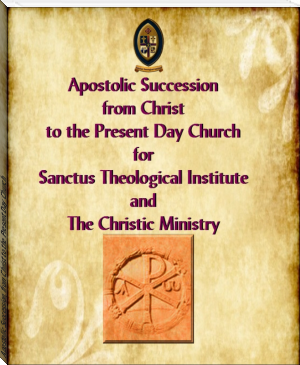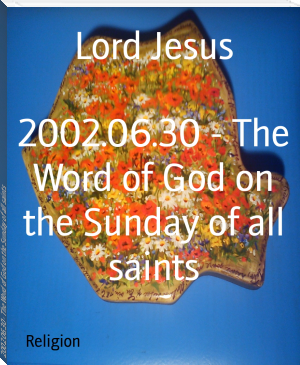Principles of Teaching by Adam S. Bennion (feel good novels .TXT) 📖

- Author: Adam S. Bennion
- Performer: -
Book online «Principles of Teaching by Adam S. Bennion (feel good novels .TXT) 📖». Author Adam S. Bennion
"Such rapid-fire questioning, Miss Stevens rightly holds, defeats its own ends. It maintains a nervous tension in the classroom that must in the long run be injurious. More than that, it is a symptom of the fact that the real work of the hour is being done by the teacher, and the pupil's share is reduced simply to brief, punctuation-like answers to the teacher's questions. Such questions appeal to mere memory or to superficial judgment rather than to real thought; they cultivate in the pupil neither independent judgment nor the power of expression; they ignore individual needs and discourage initiative; they make out of the classroom a place to display knowledge, rather than a laboratory in which to acquire it.
"The second half of the proposition, that most Sunday school teachers do not ask questions enough, has not been established by any such investigation as that of Miss Stevens. A similar study, on the basis of complete stenographic reports, of typical Sunday school lessons, would be a most valuable addition to our resources in the field of religious pedagogy. Till such a study is made, one must simply record his conviction that Sunday school teachers, as a general rule, ask too few, rather than too many questions. This conviction is based upon general observation and upon the frequency of such remarks as, 'I just can't get my class to study,' 'There are only two or three who ever answer my questions,' 'My pupils don't know anything about the Bible,' 'As long as I do all the talking, things go all right,' etc." Weigle, Talks to Sunday School Teachers.
The whole matter of questioning can be made to stand out most clearly, perhaps, by listing the various types of question, the purposes which each type serves, and the characteristics of a good question.
First of all there is the Review question. The great purpose of this type of question is to systematize knowledge. Of course, it is valuable as an aid to recollection—it is a challenge to memory—but it is particularly helpful in that it makes the big essential points in a course stand out in relief with minor points properly correlated and subordinated. The review question is a guide to the pupil whereby he may see the relative significance of the work he has covered. One of our great difficulties lies in the fact that our teaching is so largely piece-meal. Today's lesson is hurried through, isolated as it is from all that has gone before and all that may follow. The successful teacher through the review makes each lesson a link in the chain of thought that underlies the whole development of the subject in hand.
The review question is essentially a carefully thought out, searching inquiry. It calls for a turning over, in the mind, of the material of the whole course and therefore should allow ample time for pondering. If it does not stimulate a "weighing process," it likely is merely a fact question—a test of memory. Of course, there is a place at times for this hurried type of question, but it serves the purpose only of "connecting up" and should not be mistaken for the evaluating question of review.
The following questions on the expulsion of the Saints from Missouri are illustrative review questions:
1. To what extent, if any, were the Latter-day Saints themselves responsible for their expulsion from Missouri?
2. To what extent were the persecutions of Missouri political? Religious?
3. How do you account for the fact that the Lord's people have always been a chastened people?
4. Show how the Missouri persecutions have been ultimately a blessing to the Latter-day Saints.
The second type of question is the fact question. It serves to check up on mental alertness and recall. It is often helpful in arresting attention and therefore has a certain disciplinary function. The teacher, of course, must make sure that his pupils are grasping the subject-matter presented, and the fact question serves admirably as a test of knowledge. It is usually a short question calling for a short answer, and therefore may be used in a rapid-fire way that stimulates thought. It is this type of question that is hurled so frequently at classes with the consequences pointed out in the quotation from Miss Stevens.
The same author lists as objections to the continued use of these rapid-fire questions the following bad features. They result in:
1. Nervous tension. 2. The teacher's doing most of the work. 3. Emphasis upon memory and superficial judgment. 4. Little time for the art of expression. 5. Little attention to the needs of particular individuals in a class. 6. The class being made a place for displaying knowledge. 7. Little self-reliant, independent thinking.As illustrative of the fact question may we set down the following:
Who was Joseph Smith? What was his father's name? What was his mother's name? Where was he born? How old was he when he received his first vision? When did he receive the plates?The challenging question and the leading question are closely enough allied that we may well discuss them together. They are both intended to provoke creative thinking. The leading question aims to capitalize on what is already in the pupil's mind in getting him to go one step further to a conclusion we already have in mind. Instead of telling a class of young children that Joseph Smith prayed to the Lord for help in choosing the church to which he might best belong, we might proceed by saying that the Prophet had asked his father and mother—he had asked his best friends—he had talked with all the ministers he could find—he had read in all of the available books—now who can tell what else he could do? The chief merit of the leading question lies in the fact that it paves the way for the answer. It is particularly helpful in encouraging young and backward pupils. But is easily subject to abuse. So much so that its use is very largely restricted in law courts. It results too frequently in the teacher's thinking for the pupil, and therefore ought to be used with care.
The challenging question is the question that fosters originality of thought, independence of judgment. It simply raises a problem and leaves pupils free to arrive at their own conclusions. It makes for an intelligent faith so much desired in a democratic Church such as ours. It is the one question above all others that guarantees a vital class distinction.
Of course, there is a place for all four of these types of questions. As was said relative to the methods of the recitation, the best method is a variety of methods. So with questions. It is perfectly clear, however, that for general purposes that question which prompts greatest reflection and independent thinking is the best one to indulge most frequently. The following questions out of a lesson on Joseph Smith's First Vision are set down as typical of thought-provoking questions:
1. In view of the fact that when men choose a man for president of a bank they look for a man of maturity and experience, how do you explain that Joseph Smith, a mere boy, with little training or experience, was entrusted with the great responsibility of founding what we claim is the greatest institution of these latter days?
2. How can you convince the world that a just God would declare that none of their churches is right?
3. What vital truths are announced to the world through his first vision?
Let us conclude this chapter with one more quotation from Miss Stevens. When asked to name the three outstanding characteristics of a good question, she set them down as follows:
1. A good question should stimulate reflection.
2. It should be adapted to the experience of the pupil.
3. It should draw forth a well-rounded answer.
Questions on Questioning
Do I call on my pupils to recite in a fixed order, according to alphabet or seating, so that they are warned not to attend till their turn comes?
Do I name the pupil who is to answer before I put the question?
Do I ask direct questions or alternative questions which can be answered without knowledge or thought?
Do I ask chiefly fact questions?
Do I ask leading or suggestive questions?
Do I repeat my questions? Attention.
Do I answer my own questions?
Do I ask confusing, changed questions?
Do I ask foolish questions that no one can answer?
Do my questions make pupils think?
Do my questions follow up the answer and lead to new organization of knowledge?
Do I repeat the pupil's answer?
Do my questions reach all the members of the class?
Do I make the recitation an inquisition, or do I pursue a slow pupil and listen while pupils express themselves freely and naturally?
Questions and Suggestions—Chapter XXI
1. Why is it essential that we prepare questions as we do other material?
2. What are the dangers that attend the asking of a great number of fact questions?
3. Discuss the relative value of the "W's"—what, who, when, where, and why.
4. Discuss each of the questions on questioning in this chapter.
5. Bring in three thought-provoking questions on one of the current lessons in the month's work of one of the auxiliary organizations.
Helpful References
Fitch, The Art of Questioning; Stevens, The Question as a Measure of Efficiency in Instruction; Weigle, Talks to Sunday School Teachers; Horne, Story Telling, Questioning, and Studying; Brumbaugh, The Making of a Teacher; Driggs, The Art of Teaching.
CHAPTER XXII THE PROBLEM OF DISCIPLINEOutline—Chapter XXII
A popular misconception of discipline.—Discipline inherent in teaching.—Importance of discipline in our religious teaching.—Changed attitude within the past three centuries toward discipline.—What discipline is.
Methods of securing discipline: The method of rewards; The method of "pleasing the teacher"; The method of punishment; The method of social appeal; The method of interest.
The importance of a proper attitude on the part of one who disciplines.—What constitutes such an attitude?
Back in 1916 the writer of these chapters was invited to address a group of teachers on the subject of discipline. This particular lecture came toward the end of a series of lectures given on the various pedagogical truths underlying teaching. One particular teacher, who had listened to all of the lectures, expressed appreciation of the fact that discipline was to be discussed—it apparently was his one concern, as indicated in his remark:
"We have listened to some excellent theories in these lectures. But I have to teach a class of real live boys and girls. How can I keep the little rascals quiet long enough to work the theories out?"
The remark expresses admirably the attitude of very many teachers relative to discipline. They regard teaching as one thing—discipline as quite another. With them discipline involves some sort of magic process or the application of some iron rule authority, which secures order that teaching may then be indulged in. As a matter of fact, discipline is inherent in good teaching. It is not a matter of correction so much as a matter of prevention. The good disciplinarian anticipates disorder—directs the energies of his pupils so that the disorder is made impossible by attention to legitimate interests.
Discipline is one of the most pressing problems in the quorums and organizations of the Church today. On every hand the complaint is registered that proper respect is not shown, either for those in important positions or for our places of worship.
The spirit that accompanies the political rally





Comments (0)